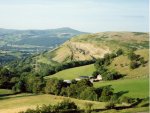 Gilwern Hill (ahead) as seen from Llanelly Hill, above the Clydach Gorge. The tip of Saint Giles series almost makes it to the edge of the escarpment. The stream that flows North through Gilwern Passage, Galeria Garimpeiros and Saint Giles, resurges at the base of the quarry in the picture.
Gilwern Hill (ahead) as seen from Llanelly Hill, above the Clydach Gorge. The tip of Saint Giles series almost makes it to the edge of the escarpment. The stream that flows North through Gilwern Passage, Galeria Garimpeiros and Saint Giles, resurges at the base of the quarry in the picture.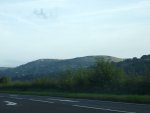 Gilwern Hill as seen from the road between Crickhowell and Abergavenny. Waterfall Series ends under the radio mast on its left side (almost meeting Ogof Ddwy Sir, which starts in the obvious quarry near the mast). Galaria Garimpeiros and Saint Giles series take up the middle and right side, a little lower than the quarries.
Gilwern Hill as seen from the road between Crickhowell and Abergavenny. Waterfall Series ends under the radio mast on its left side (almost meeting Ogof Ddwy Sir, which starts in the obvious quarry near the mast). Galaria Garimpeiros and Saint Giles series take up the middle and right side, a little lower than the quarries.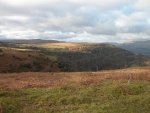 Gilwern Hill (ahead) and Pwll Du (left). On the far left is the Lamb and Fox pub, and the white building is the Pwll Du Adventure Centre, above the entrance.
Waterfall Series ends under the radio mast on Gilwern Hill, The Nunnery ends near the tree line on Pwll Du, and the camera is situated over the top end of Big Country.
Gilwern Hill (ahead) and Pwll Du (left). On the far left is the Lamb and Fox pub, and the white building is the Pwll Du Adventure Centre, above the entrance.
Waterfall Series ends under the radio mast on Gilwern Hill, The Nunnery ends near the tree line on Pwll Du, and the camera is situated over the top end of Big Country. Northern end of Tyla Quarry on the eastern side of Gilwern Hill, looking towards The Blorenge. Large Shelter can be seen as a dark square near its far end. Rift Dig is a small shadow below it. Rift Cave's path can be seen sloping up near the right end of the quarry. Waterfall Series ends behing the mast on the right, with The Realm Of Baron Von Carno and Saint Giles Series behind it. Megadrive is in the distant mountain behind the green triangular ridge. The far end of the cave is twice as far as the right edge of The Blorenge.
Northern end of Tyla Quarry on the eastern side of Gilwern Hill, looking towards The Blorenge. Large Shelter can be seen as a dark square near its far end. Rift Dig is a small shadow below it. Rift Cave's path can be seen sloping up near the right end of the quarry. Waterfall Series ends behing the mast on the right, with The Realm Of Baron Von Carno and Saint Giles Series behind it. Megadrive is in the distant mountain behind the green triangular ridge. The far end of the cave is twice as far as the right edge of The Blorenge. Tyla Quarry, on the eastern side of Gilwern Hill. This contains numerous short caves. Bolder Land in Waterfall Series runs parallel to the quarry, about 100 metres behind the quary face. Outer Quarry Cave sits over the bank on the left. Box Cave and Ogof Gwyfyn are part way along the upper face on the left. Large Shelter is half way along the upper face, and half way up it. Rift Dig is in the middle of the lower face on the left, and Rift Cave is at the far end of it. In the distant corner is an unnamed little cave.
Tyla Quarry, on the eastern side of Gilwern Hill. This contains numerous short caves. Bolder Land in Waterfall Series runs parallel to the quarry, about 100 metres behind the quary face. Outer Quarry Cave sits over the bank on the left. Box Cave and Ogof Gwyfyn are part way along the upper face on the left. Large Shelter is half way along the upper face, and half way up it. Rift Dig is in the middle of the lower face on the left, and Rift Cave is at the far end of it. In the distant corner is an unnamed little cave. Large Shelter.
Large Shelter. Large Shelter choke, which points towards Bolder Land. However, the cave is in the Llanelly Shales, so it is unlikely to be related to it.
Large Shelter choke, which points towards Bolder Land. However, the cave is in the Llanelly Shales, so it is unlikely to be related to it. Pwll Du as seen from The Blorenge.
On the right, the prominent white building is the Pwll Du Adventure Centre, with the entrance at the tree line on the slope below it.
The white building to its left is the Lamb and Fox pub, with Lamb and Fox chamber below the fields in front of it.
Megadrive runs behind the quarry, with Canyon, Raiders, The Score and Beyond a Choke Streamway behind it.
The Nunnery, Players Tunnel, and Erection Series end in the green patch to the left of the quarry.
The little valley to the left (The Tumble) is on top of The Wyvern Extensions.
Big Country starts at the left edge of the picture.
Pwll Du as seen from The Blorenge.
On the right, the prominent white building is the Pwll Du Adventure Centre, with the entrance at the tree line on the slope below it.
The white building to its left is the Lamb and Fox pub, with Lamb and Fox chamber below the fields in front of it.
Megadrive runs behind the quarry, with Canyon, Raiders, The Score and Beyond a Choke Streamway behind it.
The Nunnery, Players Tunnel, and Erection Series end in the green patch to the left of the quarry.
The little valley to the left (The Tumble) is on top of The Wyvern Extensions.
Big Country starts at the left edge of the picture.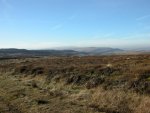 The ridge of tips above Pwll Du, seen from The Blorenge, over the top of War Of The Worlds. Beyond A Choke Streamway runs under the ridge.
Gilwern Hill is barely visible to the right. The Keeper's Pond can be seen in the middle, and Big Country is under the area between that and the camera.
The ridge of tips above Pwll Du, seen from The Blorenge, over the top of War Of The Worlds. Beyond A Choke Streamway runs under the ridge.
Gilwern Hill is barely visible to the right. The Keeper's Pond can be seen in the middle, and Big Country is under the area between that and the camera.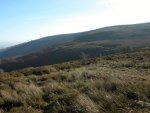 Mynydd y Garn-fawr on the far side of The Blorenge. Prisoners Of War nearly reaches the surface here.
Mynydd y Garn-fawr on the far side of The Blorenge. Prisoners Of War nearly reaches the surface here. Blaenavon, seen from Big Pit. Beyond A Choke Streamway runs under the ridge on the left, and ends under the housing estate (not the industrial estate) slightly to the right of the middle of the picture. The largest part of War Of The Worlds South is under the two masts on the left of the picture, and Luck Of The Draw ends under the green fields above the houses on the right side of the picture.
Blaenavon, seen from Big Pit. Beyond A Choke Streamway runs under the ridge on the left, and ends under the housing estate (not the industrial estate) slightly to the right of the middle of the picture. The largest part of War Of The Worlds South is under the two masts on the left of the picture, and Luck Of The Draw ends under the green fields above the houses on the right side of the picture. Rifleman's Arms pub. Rifleman's chamber, the end of Beyond A Choke Streamway, ends under the housing estate just behind and to the right of it.
In the distance on the Right are the fields which are over the top of the end of Luck Of The Draw in Dollimore Series, the furthest point of the cave.
Rifleman's Arms pub. Rifleman's chamber, the end of Beyond A Choke Streamway, ends under the housing estate just behind and to the right of it.
In the distance on the Right are the fields which are over the top of the end of Luck Of The Draw in Dollimore Series, the furthest point of the cave. Abersychan, in front of the Victoria Village primary school, overlooking the Nant Ffrwd stream valley. Ogof Pwll Maelor lies in the Nant Maelor valley up the main valley from here (to the left, behind the camera), and has been die traced to the Snatchwood Bridge Risings.
Abersychan, in front of the Victoria Village primary school, overlooking the Nant Ffrwd stream valley. Ogof Pwll Maelor lies in the Nant Maelor valley up the main valley from here (to the left, behind the camera), and has been die traced to the Snatchwood Bridge Risings.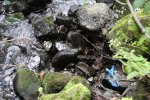 The Nant Ffrwd sink. The water probably joins the Ogof Draenen flow.
The Nant Ffrwd sink. The water probably joins the Ogof Draenen flow.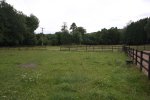 In the main valley just downstream of mouth of the Nant Ffrwd valley is a flood overflow resurgence, in a private field next to the Afon Lwyd river. Seen here as a clump of trees surrounded by a fence.
In the main valley just downstream of mouth of the Nant Ffrwd valley is a flood overflow resurgence, in a private field next to the Afon Lwyd river. Seen here as a clump of trees surrounded by a fence.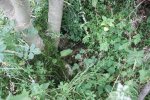 One of the choked resurgence holes in the clump of trees.
One of the choked resurgence holes in the clump of trees.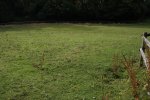 The surface of the field next to the flood overflow resurgence (away from the river) rises up under hydrological pressure during extreme floods, like a water cushion that you can walk on - an almost unique feature. This is known as The Bouncing Field.
The surface of the field next to the flood overflow resurgence (away from the river) rises up under hydrological pressure during extreme floods, like a water cushion that you can walk on - an almost unique feature. This is known as The Bouncing Field. The funeral parlour in Snatchwood. The footbridge beside this is Snatchwood bridge.
The funeral parlour in Snatchwood. The footbridge beside this is Snatchwood bridge.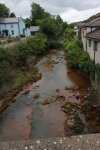 Upstream (on the right bank as seen here) is the entrance to Ogof Ysbyty Pontypool, one of the Ogof Draenen resurgences.
Upstream (on the right bank as seen here) is the entrance to Ogof Ysbyty Pontypool, one of the Ogof Draenen resurgences.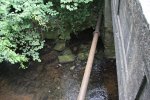 Snatchwood Bridge Risings line the downstream side of the bridge, across the whole width of the river.
Snatchwood Bridge Risings line the downstream side of the bridge, across the whole width of the river. The Pontnewynydd tower block. Under the foundations of one corner of the tower block is the "bottomless pit" of Pontnewynydd Risings, discovered while the tower block was being built. The smaller building on its left is the pumphouse, which extracts water that rises through sand and gravel. This is the main Pontnewynydd Risings, one of the main resurgences for Ogof Draenen. The water is used to flush the local sewers.
The Pontnewynydd tower block. Under the foundations of one corner of the tower block is the "bottomless pit" of Pontnewynydd Risings, discovered while the tower block was being built. The smaller building on its left is the pumphouse, which extracts water that rises through sand and gravel. This is the main Pontnewynydd Risings, one of the main resurgences for Ogof Draenen. The water is used to flush the local sewers.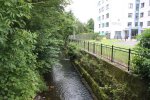 Outflow in the main river next to the tower block. This is the overflow from the main risings.
Outflow in the main river next to the tower block. This is the overflow from the main risings. Entrance gate
Entrance gate Entrance crawl
Entrance crawl Entrance crawl
Entrance crawl Scaffolded climbs
Scaffolded climbs Old gate crawl
Old gate crawl Stream crawl in flood
Stream crawl in flood Stream crawl
Stream crawl Wet climb
Wet climb Scaffolded Shaft
Scaffolded Shaft Spare Rib corkscrew
Spare Rib corkscrew Spare Rib corkscrew
Spare Rib corkscrew Mouse skeleton
Mouse skeleton Chert banded cascade
Chert banded cascade Darling Rifts
Darling Rifts Darling Rifts
Darling Rifts Darling Rifts
Darling Rifts Darling Rifts
Darling Rifts Climb to Big Bang
Climb to Big Bang Pitch Bypass upper level
Pitch Bypass upper level Ctenacanthus dorsal spine
Ctenacanthus dorsal spine Pitch Bypass formation
Pitch Bypass formation Harvestman
Harvestman 4 m roped climb
4 m roped climb 4 m roped climb
4 m roped climb 4 m roped climb
4 m roped climb 4 m roped climb in flood
4 m roped climb in flood Chamber before Bing Bang
Chamber before Bing Bang Big Bang Pitch head
Big Bang Pitch head Ctenacanthus dorsal spine
Ctenacanthus dorsal spine Larger ctenacanthus spine
Larger ctenacanthus spine Ctenacanthus spine detail
Ctenacanthus spine detail Another spine
Another spine Psammodus Passage fossil
Psammodus Passage fossil Fossil detail
Fossil detail Psammodus Passage vermiculations
Psammodus Passage vermiculations Fossil bone
Fossil bone Fossil bone
Fossil bone Rock patterns
Rock patterns Undercut stal
Undercut stal The Strawberries pool
The Strawberries pool The Strawberries
The Strawberries Popplers?
Popplers? Strawberry crystals
Strawberry crystals KFC popcorn?
KFC popcorn? Upstream Beyond A Choke
Upstream Beyond A Choke Cracked mud
Cracked mud Cracked mud
Cracked mud Cracked mud
Cracked mud Big Bang Pitch
Big Bang Pitch Ruckle slope
Ruckle slope Upstream Passage
Upstream Passage Drip pockets
Drip pockets Upstream Passage grotto
Upstream Passage grotto Upstream Passage grotto
Upstream Passage grotto Mud fill
Mud fill Upstream Passage
Upstream Passage Upstream Passage
Upstream Passage Rift climb
Rift climb Dry waterfall
Dry waterfall Narrow climb
Narrow climb The waterfall
The waterfall Climb to Outcast Passage
Climb to Outcast Passage Outcast Passage south
Outcast Passage south Harvestman
Harvestman Outcast Passage
Outcast Passage Karren weathering
Karren weathering Gypsum crust
Gypsum crust Gypsum finger
Gypsum finger Gypsum flowers
Gypsum flowers Gypsum flowers
Gypsum flowers Long gypsum flower
Long gypsum flower Long gypsum flower
Long gypsum flower 360 ° curl
360 ° curl 360 ° curl
360 ° curl Gypsum flowers
Gypsum flowers Boxwork
Boxwork Climb to higher level
Climb to higher level First crawl start
First crawl start Brief rest
Brief rest Tight side passage
Tight side passage First squeeze
First squeeze Second crawl
Second crawl Second squeeze
Second squeeze Iron nodules
Iron nodules Iron nodules
Iron nodules Outcast Passage
Outcast Passage Outcast Passage
Outcast Passage Immature helictites
Immature helictites Ctenacanthus spine
Ctenacanthus spine Short larger passage
Short larger passage Outcast Passage
Outcast Passage Knees Up Mother Brown
Knees Up Mother Brown Knees Up Mother Brown
Knees Up Mother Brown Knees Up Mother Brown
Knees Up Mother Brown Knees Up Mother Brown
Knees Up Mother Brown Knees Up Mother Brown
Knees Up Mother Brown Scalloped wall
Scalloped wall 6th Heaven Chamber
6th Heaven Chamber 6th Heaven Chamber
6th Heaven Chamber Mud formations
Mud formations Mud splash formation
Mud splash formation Hoodoos
Hoodoos Anthodites
Anthodites Anthodites
Anthodites Anthodites and helictites
Anthodites and helictites Anthodites and helictites
Anthodites and helictites Anthodites
Anthodites Anthodite collection
Anthodite collection Aragonite urchins
Aragonite urchins Large anthodites
Large anthodites Anthodites
Anthodites Anthodites and helictites
Anthodites and helictites Anthodites on flowstone
Anthodites on flowstone Urchins
Urchins Anthodites
Anthodites Anthodites
Anthodites Millstone grit choke
Millstone grit choke Second chamber anthodites
Second chamber anthodites Aragonite anthodites
Aragonite anthodites Aragonite end
Aragonite end Anthodites
Anthodites Anthodites
Anthodites Anthodites
Anthodites Anthodites
Anthodites Side passage anthodites
Side passage anthodites Lost River
Lost River Lost River stal
Lost River stal Lost River stal
Lost River stal Lost River anthodites
Lost River anthodites Anthodites
Anthodites Lost River stal
Lost River stal Lost River
Lost River Lost River stal
Lost River stal Lost River
Lost River Lost River chamber
Lost River chamber Calcite arch
Calcite arch Gypsum and ochres
Gypsum and ochres Cryostal
Cryostal Yes Passage
Yes Passage Yes Passage
Yes Passage Getting lower
Getting lower Muddy crawl
Muddy crawl Padlock Passage choke
Padlock Passage choke Cryostal
Cryostal Padlock Passage
Padlock Passage Caddisfly
Caddisfly Shattered ceiling
Shattered ceiling Padlock Passage
Padlock Passage Padlock Passage
Padlock Passage Padlock Passage
Padlock Passage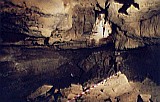 Padlock Passage
Padlock Passage Phreatic pendants
Phreatic pendants Entry to Bolder Land
Entry to Bolder Land Bolder Land alternative
Bolder Land alternative Bolder Land formations
Bolder Land formations Choke squeeze
Choke squeeze Pit room
Pit room Deep pit
Deep pit Cryostal
Cryostal Cryostal
Cryostal Cryostal
Cryostal Cryostal
Cryostal Cryostal
Cryostal Gypsum crystal
Gypsum crystal Ledge crawl
Ledge crawl Mousetrap
Mousetrap Jammed boulders
Jammed boulders Shattered wall
Shattered wall Jammed boulder
Jammed boulder Undercut stream
Undercut stream Undercut cryostal
Undercut cryostal Cryostal
Cryostal Cryostal
Cryostal Cryostal
Cryostal Cryostal
Cryostal Cryostal
Cryostal Fractured slab
Fractured slab Peeling wall
Peeling wall Ctenacanthus spine
Ctenacanthus spine Cryostal
Cryostal Cryostal
Cryostal Cryostal
Cryostal Cryostal
Cryostal Cryostal
Cryostal Cryostal
Cryostal Cryostal
Cryostal Cryostal
Cryostal Cryostal
Cryostal Cryostal
Cryostal Cryostal
Cryostal Cryostal
Cryostal Cryostal
Cryostal Cryostal
Cryostal Cryostal
Cryostal Cryostal
Cryostal Cryostal
Cryostal Cryostal
Cryostal Jammed boulders
Jammed boulders Rock arch
Rock arch Leaning pillar
Leaning pillar Goethite beds
Goethite beds Bolder Land
Bolder Land Ctenacanthus spine
Ctenacanthus spine Stable rift
Stable rift Ctenacanthus spine
Ctenacanthus spine Cryostal
Cryostal Corner pit
Corner pit Bolder Land
Bolder Land Jammed boulders
Jammed boulders Unstable wall
Unstable wall Shark fossil
Shark fossil Nautiloid
Nautiloid Phreatic arch
Phreatic arch Cryostal
Cryostal Cryostal
Cryostal Ochre ceiling
Ochre ceiling Cryostal
Cryostal Cryostal
Cryostal Cryostal
Cryostal Cryostal
Cryostal Cryostal
Cryostal Cryostal
Cryostal Cryostal
Cryostal Cryostal
Cryostal Cryostal
Cryostal Cryostal
Cryostal Conglomerate aven
Conglomerate aven Calcite and manganese
Calcite and manganese Conglomerate
Conglomerate Calcite and manganese
Calcite and manganese Conglomerate
Conglomerate Conglomerate chamber
Conglomerate chamber Calcite and manganese
Calcite and manganese Final chamber
Final chamber Conglomerate wall
Conglomerate wall Cairn Junction
Cairn Junction Porrhomma rosenhaueri
Porrhomma rosenhaueri Porrhomma rosenhaueri
Porrhomma rosenhaueri Porrhomma rosenhaueri skin
Porrhomma rosenhaueri skin Calathus cf. rotundicollis
Calathus cf. rotundicollis Oxbow laminates
Oxbow laminates Bypassed climbs
Bypassed climbs Wonderbra slab
Wonderbra slab Before Tea Junction
Before Tea Junction Tea Junction
Tea Junction Below Gilwern Passage
Below Gilwern Passage Traverse
Traverse Cascade
Cascade Cascade
Cascade Cascade
Cascade Stal bank
Stal bank Balcony flowstone
Balcony flowstone Decorated section
Decorated section The Sentinel
The Sentinel Climb to upper level
Climb to upper level Upper level
Upper level Climb to Bit Of A Dive
Climb to Bit Of A Dive The Soap Bar
The Soap Bar Before The Confluence
Before The Confluence Textured mud
Textured mud Textured mud
Textured mud After The Confluence
After The Confluence Wide section
Wide section The Rhino
The Rhino Taller section
Taller section Wide keyhole section
Wide keyhole section Large phreatic section
Large phreatic section Fallout climb
Fallout climb Arched section
Arched section Getting taller
Getting taller Deeper section
Deeper section Deep pool
Deep pool Rippled sand
Rippled sand The deepest pool
The deepest pool The deepest pool
The deepest pool Boulder floor
Boulder floor Rifleman's Chamber
Rifleman's Chamber Ladder above choke
Ladder above choke Ladder above choke
Ladder above choke Chamber above Rifleman's Chamber
Chamber above Rifleman's Chamber Rifleman's dig
Rifleman's dig Rifleman's dig
Rifleman's dig Rifleman's dig
Rifleman's dig Rifleman's dig
Rifleman's dig Stalagmite flow
Stalagmite flow Sediment bank
Sediment bank Calcite rafts
Calcite rafts Giles' Shirt
Giles' Shirt Giles' Shirt flow
Giles' Shirt flow Flow closeup
Flow closeup Giles' Shirt crystal pool
Giles' Shirt crystal pool 150 metre straight section
150 metre straight section 150 metre straight section
150 metre straight section Sand ripples
Sand ripples Largest section
Largest section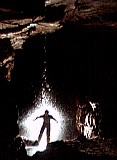 Inlet waterfall
Inlet waterfall Protected formation
Protected formation Protected formation
Protected formation Blistered calcite floor
Blistered calcite floor Bouldery section
Bouldery section Calcite dribbles
Calcite dribbles Boulder obstacles
Boulder obstacles More boulders
More boulders Tiny gypsum flowers
Tiny gypsum flowers Selenite crystals
Selenite crystals Selenite crystals
Selenite crystals Selenite crystals
Selenite crystals Selenite crystals
Selenite crystals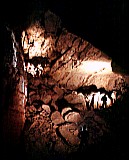 Old Illtydian's Chamber
Old Illtydian's Chamber Old Illtydian's Chamber
Old Illtydian's Chamber Old Illtydian's stal
Old Illtydian's stal Old Illtydian's stal
Old Illtydian's stal Old Illtydian's ceiling
Old Illtydian's ceiling Pool with sunken rafts
Pool with sunken rafts Stal flow between pools
Stal flow between pools Passage between pools
Passage between pools Second pool
Second pool Third pool
Third pool Side passage calcite rafts
Side passage calcite rafts Side passage calcite rafts
Side passage calcite rafts Fourth pool calcite rafts
Fourth pool calcite rafts Cryostal
Cryostal Rift passage
Rift passage Grotto at the end
Grotto at the end Wet crawl
Wet crawl Initial squeeze
Initial squeeze Initial squeeze
Initial squeeze Initial squeeze
Initial squeeze Mud formations
Mud formations Forever Changed start
Forever Changed start Forever Changed
Forever Changed Forever Changed curtain
Forever Changed curtain Straws
Straws The Guardian
The Guardian The Guardian
The Guardian Path between straws
Path between straws Straws
Straws Y Gwter Fawr junction
Y Gwter Fawr junction Brownout on Breadfruit Boulevard
Brownout on Breadfruit Boulevard Brownout on Breadfruit Boulevard
Brownout on Breadfruit Boulevard Brownout on Breadfruit Boulevard
Brownout on Breadfruit Boulevard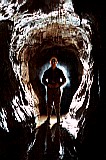 Hearts of Olden Glory
Hearts of Olden Glory Collapse chamber
Collapse chamber Cryostal
Cryostal Side chamber
Side chamber Cryostal
Cryostal Sons of the Pioneers
Sons of the Pioneers Sons of the Pioneers
Sons of the Pioneers Sons of the Pioneers
Sons of the Pioneers Sons of the Pioneers
Sons of the Pioneers Sons of the Pioneers
Sons of the Pioneers Sons of the Pioneers
Sons of the Pioneers Another World
Another World Another World arch
Another World arch Another World
Another World Another World carrots
Another World carrots Phreatic tube
Phreatic tube Phreatic tube (2)
Phreatic tube (2) Climb to Indigo Rift
Climb to Indigo Rift Indigo Rift
Indigo Rift Climb to Violate Passage
Climb to Violate Passage Violate Passage
Violate Passage Awkward Climb
Awkward Climb Violate Passage mud
Violate Passage mud Violate Passage
Violate Passage Calcite at Running Commentary
Calcite at Running Commentary Violate Passage
Violate Passage Fastrack Membership
Fastrack Membership Violate Passage
Violate Passage Violate Passage crawl.
Violate Passage crawl. Violate Passage crawl
Violate Passage crawl Violate Passage crawl
Violate Passage crawl Stream of Running Commentary
Stream of Running Commentary Z-bend
Z-bend Z-bend
Z-bend Running Commentary
Running Commentary Running Commentary
Running Commentary Running Commentary
Running Commentary Running Commentary mud
Running Commentary mud Running Commentary mud
Running Commentary mud Running Commentary
Running Commentary Running Commentary
Running Commentary Running Commentary mud
Running Commentary mud Running Commentary
Running Commentary Violate Passage crossroads
Violate Passage crossroads Choked avens
Choked avens Running Commentary
Running Commentary Side passage mud
Side passage mud Side passage mud
Side passage mud Running Commentary climb
Running Commentary climb Running Commentary
Running Commentary Side passage
Side passage Side passage
Side passage Side passage
Side passage Running Commentary
Running Commentary Running Commentary rift
Running Commentary rift Running Commentary rift
Running Commentary rift Running Commentary choke
Running Commentary choke Above the choke
Above the choke Squeeze to Baron Von Carno
Squeeze to Baron Von Carno Kababarama Drama side passage
Kababarama Drama side passage Side passage
Side passage Side passage mud
Side passage mud Side passage
Side passage Side passage mud
Side passage mud Side passage
Side passage Cryostal
Cryostal Side passage choke
Side passage choke Kababarama Drama side rift
Kababarama Drama side rift Side rift
Side rift Side rift link
Side rift link Side rift
Side rift Side rift
Side rift Kababarama Drama route
Kababarama Drama route Side passage
Side passage Ceiling climb
Ceiling climb Ceiling climb
Ceiling climb Ceiling climb
Ceiling climb Upper side passage
Upper side passage Upper side passage
Upper side passage Upper side passage
Upper side passage Cryostal
Cryostal Main route
Main route Rift squeeze
Rift squeeze Side passage
Side passage Side passage
Side passage Cryostal
Cryostal Main route crawl
Main route crawl Main route
Main route Main route
Main route Large main route
Large main route Powder deposit
Powder deposit Roof tube
Roof tube End of large passage
End of large passage Powder deposit
Powder deposit Powder deposit
Powder deposit Powder deposit
Powder deposit Side passage
Side passage Main route
Main route Main route
Main route Main route squeeze
Main route squeeze Main route
Main route Cryostal
Cryostal Main route climb
Main route climb Main route
Main route Main route mud
Main route mud Main route
Main route Dead end
Dead end Side passage choke
Side passage choke Side passage
Side passage Side passage climb
Side passage climb Side passage end
Side passage end Cryostal rafts
Cryostal rafts Squeeze back to roof tube
Squeeze back to roof tube Main route
Main route Cryostal
Cryostal Kababarama Drama
Kababarama Drama Kababarama Drama
Kababarama Drama Kababarama Drama
Kababarama Drama Side alcoves
Side alcoves Squeeze to southern rift
Squeeze to southern rift Cryostal
Cryostal Rift stal
Rift stal Rift above
Rift above Climb to Violate Passage
Climb to Violate Passage Towards Nevill Hall
Towards Nevill Hall Boulder collapse
Boulder collapse Rope climb
Rope climb Double traverse
Double traverse Towards Nevill Hall
Towards Nevill Hall Towards Nevill Hall
Towards Nevill Hall Cryostal
Cryostal Drip pockets
Drip pockets Climb up
Climb up Rope climb
Rope climb Choke
Choke Towards Nevill Hall
Towards Nevill Hall Cryostal
Cryostal Partly flooded side passage
Partly flooded side passage Hole to Passendale
Hole to Passendale Climb into Nevill Hall
Climb into Nevill Hall Start of Nevill Hall
Start of Nevill Hall Nevill Hall
Nevill Hall Nevill Hall
Nevill Hall Nevill Hall
Nevill Hall Nevill Hall
Nevill Hall Side passage
Side passage Side passage climb
Side passage climb Side passage chamber
Side passage chamber Cryostal
Cryostal Cryostal in soakaway
Cryostal in soakaway Cryostal
Cryostal Cryostal
Cryostal Flowstone
Flowstone Seasonal sump
Seasonal sump Mud formations
Mud formations Climb beyond Nevill Hall
Climb beyond Nevill Hall Helictites
Helictites Beyond Nevill Hall
Beyond Nevill Hall Beyond Nevill Hall
Beyond Nevill Hall Cryostal
Cryostal Large cryostal cups
Large cryostal cups Large cryostal cups
Large cryostal cups Large cryostal cups
Large cryostal cups Cryostal
Cryostal Traverse to the end
Traverse to the end Mud below the traverse
Mud below the traverse Mud formations
Mud formations Mud formations
Mud formations Mud formations
Mud formations Mud formations
Mud formations Mud formations
Mud formations Mud formations at the end
Mud formations at the end Mud formations at the end
Mud formations at the end First way to Red Baron
First way to Red Baron First way to Red Baron
First way to Red Baron Dead end side passage
Dead end side passage Dead end side passage
Dead end side passage Dead end side passage
Dead end side passage First way to Red Baron
First way to Red Baron Main way to Red Baron
Main way to Red Baron Main way to Red Baron
Main way to Red Baron Junction of routes to Red Baron
Junction of routes to Red Baron Low crawl route
Low crawl route Low crawl route
Low crawl route Low crawl route
Low crawl route Low crawl route
Low crawl route Four squeeze route
Four squeeze route Four squeeze route side passage
Four squeeze route side passage First squeeze
First squeeze Second squeeze
Second squeeze Fourth squeeze
Fourth squeeze Four squeeze route
Four squeeze route Passendale junction
Passendale junction Passendale rift
Passendale rift Passendale crawl
Passendale crawl Passendale gypsum
Passendale gypsum Passendale upstream
Passendale upstream Passendale upstream
Passendale upstream Passendale upstream sump
Passendale upstream sump Passendale downstream
Passendale downstream Seasonal sump open
Seasonal sump open Dead end
Dead end Climb to Nevill Hall
Climb to Nevill Hall Four squeeze route side passage
Four squeeze route side passage Low crawl and four squeeze routes
Low crawl and four squeeze routes Third way to Red Baron
Third way to Red Baron Third way to Red Baron
Third way to Red Baron Third way to Red Baron
Third way to Red Baron Cryostal
Cryostal Combined routes
Combined routes Side passage
Side passage Before The Red Baron
Before The Red Baron The Red Baron south
The Red Baron south Mud formations
Mud formations Side rift
Side rift Climb to final rift
Climb to final rift The Red Baron
The Red Baron Pink rock
Pink rock The Red Baron traverse
The Red Baron traverse Side passage
Side passage Side rift
Side rift The Red Baron
The Red Baron Side crawl
Side crawl The Red Baron
The Red Baron Hoodoos
Hoodoos The Red Baron
The Red Baron Passage to Aces High
Passage to Aces High Passage to Aces High
Passage to Aces High Aven to Aces High
Aven to Aces High Aven cryostal
Aven cryostal Inlet crostal
Inlet crostal The Red Baron wriggle
The Red Baron wriggle The Red Baron crawl
The Red Baron crawl Cryostal
Cryostal The Red Baron junction
The Red Baron junction Junction cryostal
Junction cryostal Junction cryostal
Junction cryostal Junction cryostal
Junction cryostal Side passage cryostal
Side passage cryostal Side passage cryostal
Side passage cryostal Drip pockets
Drip pockets Side passage cryostal
Side passage cryostal Side passage rift
Side passage rift The Red Baron
The Red Baron Cryostal
Cryostal Choke cryostal
Choke cryostal Cryostal
Cryostal Cryostal
Cryostal Squeeze to The Last Post
Squeeze to The Last Post The Last Post junction
The Last Post junction The Last Post northern junction
The Last Post northern junction Junction cryostal
Junction cryostal Junction cryostal
Junction cryostal Junction cryostal
Junction cryostal Junction cryostal
Junction cryostal Junction cryostal
Junction cryostal Junction cryostal
Junction cryostal Junction cryostal
Junction cryostal Side rift
Side rift Climb to blind passage
Climb to blind passage The Last Post north
The Last Post north Cryostal flakes
Cryostal flakes Cryostal flakes
Cryostal flakes Cryostal
Cryostal Cryostal
Cryostal Choked chamber
Choked chamber Chamber cryostal
Chamber cryostal Chamber cryostal
Chamber cryostal Chamber cryostal
Chamber cryostal Chamber cryostal
Chamber cryostal Chamber cryostal
Chamber cryostal Chamber cryostal
Chamber cryostal Chamber cryostal
Chamber cryostal Stalagmites
Stalagmites Stalagmite flow
Stalagmite flow Stalagmites
Stalagmites Stal
Stal Flowstone
Flowstone Flowstone
Flowstone Squeeze to northern extension
Squeeze to northern extension Northern extension
Northern extension Cryostal
Cryostal Calcite splatter
Calcite splatter Drip pockets
Drip pockets Drip pockets
Drip pockets Cryostal
Cryostal Northern-most point
Northern-most point Side passage cryostal
Side passage cryostal Cryostal
Cryostal Side passage
Side passage Side passage end
Side passage end The Last Post cryostal
The Last Post cryostal Cryostal
Cryostal Cryostal
Cryostal Cryostal
Cryostal Cryostal
Cryostal Cryostal
Cryostal Narrow rift
Narrow rift Intermediate chamber
Intermediate chamber Cryostal
Cryostal Narrow crawl
Narrow crawl Narrow crawl
Narrow crawl Narrow crawl
Narrow crawl Climb down from crawl
Climb down from crawl Side passage
Side passage Side passage cryostal
Side passage cryostal The Last Post
The Last Post The Last Post
The Last Post Tight side rift
Tight side rift The Last Post
The Last Post The Last Post
The Last Post Drip pockets
Drip pockets Calcite flow
Calcite flow Blind side passage
Blind side passage Side passage cryostal
Side passage cryostal The Last Post
The Last Post First grotto stalactites
First grotto stalactites First grotto flowstone
First grotto flowstone Redissolved calcite
Redissolved calcite The Last Post
The Last Post The Last Post second grotto
The Last Post second grotto Second grotto
Second grotto Second grotto cryostal
Second grotto cryostal Cryostal
Cryostal Mud and cryostal
Mud and cryostal Mud and cryostal
Mud and cryostal Oxbow
Oxbow Oxbow anthodites
Oxbow anthodites The Last Post end grotto
The Last Post end grotto Grotto cryostal
Grotto cryostal Stalagmite bank
Stalagmite bank Flowstone streaks
Flowstone streaks Flowstone texture
Flowstone texture Calcite coated flakes
Calcite coated flakes Mud flakes
Mud flakes The Bugle inlet
The Bugle inlet The Bugle
The Bugle The Bugle pool
The Bugle pool Dried crystal pool
Dried crystal pool Grotto stalactites
Grotto stalactites Grotto stalagmites
Grotto stalagmites Grotto end
Grotto end Calcite floor
Calcite floor Hole to Baron Von Carno
Hole to Baron Von Carno Hole to Baron Von Carno
Hole to Baron Von Carno Realm Of Baron Von Carno
Realm Of Baron Von Carno Cryostal
Cryostal Cryostal
Cryostal Mud formations
Mud formations Mud formations
Mud formations Baron Von Carno western branch
Baron Von Carno western branch Cryostal
Cryostal Cryostal
Cryostal Decomposing calcite
Decomposing calcite Western branch first chamber
Western branch first chamber Stal crawl
Stal crawl Western branch second chamber
Western branch second chamber Chamber wall
Chamber wall Gypsum
Gypsum Western branch second chamber
Western branch second chamber Western branch end
Western branch end Western branch end
Western branch end Baron Von Carno northern branch
Baron Von Carno northern branch Cryostal
Cryostal Cryostal
Cryostal Northern branch
Northern branch Cryostal
Cryostal Inlet
Inlet Northern branch
Northern branch Northern branch
Northern branch Largest chamber
Largest chamber Drip pockets
Drip pockets Cryostal
Cryostal Cryostal
Cryostal Cryostal
Cryostal Shale boulder
Shale boulder Roof tubes
Roof tubes Grotto alcove
Grotto alcove Narrow section
Narrow section Corner junction
Corner junction Cryostal
Cryostal Stal rift
Stal rift Stal rift chamber
Stal rift chamber Calcite drips
Calcite drips Dead end rifts
Dead end rifts Aces High junction
Aces High junction Wall striations
Wall striations Crawl under boulders
Crawl under boulders Chert fossils
Chert fossils Crawl under boulders
Crawl under boulders Baron Von Carno final section
Baron Von Carno final section Cryostal
Cryostal Chert fossil
Chert fossil Chert fossils
Chert fossils Roof climb
Roof climb Roof tube choke
Roof tube choke Hole to Stream Of Running Commentary
Hole to Stream Of Running Commentary Rift to Aces High
Rift to Aces High Wall textures
Wall textures First junction
First junction Old stal
Old stal Second junction
Second junction Very tight side passage
Very tight side passage Very tight side passage
Very tight side passage Dig to Aces High
Dig to Aces High Dig to Aces High
Dig to Aces High Crawl to Aces High
Crawl to Aces High Crawl to Aces High
Crawl to Aces High Cryostal
Cryostal Side passage
Side passage Side passage cryostal
Side passage cryostal Side passage cryostal
Side passage cryostal Crawl to Aces High
Crawl to Aces High Way to canyon-style side passage
Way to canyon-style side passage Cryostal
Cryostal Cryostal
Cryostal Cryostal
Cryostal Cryostal
Cryostal Cryostal
Cryostal Canyon-style side passage
Canyon-style side passage Cryostal and mud formations
Cryostal and mud formations Drip splash
Drip splash Cryostal hoodoos
Cryostal hoodoos Canyon-style side passage
Canyon-style side passage Canyon-style side passage
Canyon-style side passage Squeeze
Squeeze Blind pit
Blind pit Crystals
Crystals Cryostal
Cryostal Canyon-style side passage choke
Canyon-style side passage choke Drip pockets
Drip pockets Mouse skeleton
Mouse skeleton Side passage chamber
Side passage chamber Cryostal
Cryostal Cryostal
Cryostal Cryostal
Cryostal Stream source
Stream source Stream outflow
Stream outflow Junction with wide loop
Junction with wide loop Cryostal
Cryostal Cryostal
Cryostal Cryostal
Cryostal Cryostal
Cryostal Cryostal
Cryostal Cryostal
Cryostal Climb to chamber
Climb to chamber Biggest chamber in Aces High
Biggest chamber in Aces High Cryostal
Cryostal Cryostal
Cryostal Cryostal
Cryostal Cryostal
Cryostal Cryostal
Cryostal Cryostal
Cryostal Drip pocket
Drip pocket Ochre crust
Ochre crust Passage from the chamber
Passage from the chamber Cracked mud oxbow
Cracked mud oxbow Cryostal and mud formations
Cryostal and mud formations Cryostal
Cryostal Cryostal
Cryostal Mud flow
Mud flow Gritstone choke
Gritstone choke Cryostal
Cryostal Unstable ceiling
Unstable ceiling Slickensides
Slickensides Squeeze to narrow rift
Squeeze to narrow rift Oxbow slope
Oxbow slope Oxbow canyon
Oxbow canyon Cryostal
Cryostal Cryostal
Cryostal Cryostal
Cryostal Cryostal
Cryostal Cryostal
Cryostal Cracked mud
Cracked mud Cracked mud
Cracked mud Textured mud
Textured mud Drip pockets
Drip pockets Drip splash
Drip splash Cryostal
Cryostal Dead end canyon
Dead end canyon Cryostal
Cryostal Dead end canyon
Dead end canyon Dead end canyon's end
Dead end canyon's end Wide loop main route
Wide loop main route Cryostal
Cryostal Cryostal
Cryostal Cryostal
Cryostal Cryostal
Cryostal Cryostal
Cryostal Cryostal
Cryostal Cryostal
Cryostal Cryostal
Cryostal Cryostal
Cryostal Narrow section
Narrow section Nodules
Nodules Crystallised nodule
Crystallised nodule Cryostal
Cryostal Cryostal
Cryostal Cryostal
Cryostal Cryostal
Cryostal Climb towards smaller loop
Climb towards smaller loop Climb to wide loop
Climb to wide loop Wide loop's narrow rift
Wide loop's narrow rift Towards a dig
Towards a dig The dig
The dig Way to smaller loop
Way to smaller loop Way to smaller loop
Way to smaller loop Cryostal
Cryostal Side passage mud
Side passage mud Side passage mud
Side passage mud Side passage cryostal
Side passage cryostal Side passage cryostal
Side passage cryostal Side passage end crawl
Side passage end crawl Side passage chamber
Side passage chamber Chamber mud
Chamber mud Chamber stal
Chamber stal Main route chamber
Main route chamber Cryostal
Cryostal Cryostal
Cryostal Side passage cryostal
Side passage cryostal Side passage crawl
Side passage crawl Route to smaller loop
Route to smaller loop Oxbow mud
Oxbow mud Oxbow mud
Oxbow mud Pitch to Red Baron
Pitch to Red Baron Cryostal
Cryostal Smaller loop crawl
Smaller loop crawl Boulder junction
Boulder junction Side passage
Side passage Crater top
Crater top Cryostal
Cryostal Climb to bedding
Climb to bedding Bedding squeeze
Bedding squeeze Bedding crawl
Bedding crawl End of smaller loop
End of smaller loop Pitch to Red Baron
Pitch to Red Baron Side passage
Side passage Upstream of Carpet Crawl
Upstream of Carpet Crawl Swimming in flood
Swimming in flood Corner
Corner Corner in flood
Corner in flood Early section
Early section Beyond the climb
Beyond the climb Beyond the climb in flood
Beyond the climb in flood Downstream of Flood Overflow Passage
Downstream of Flood Overflow Passage In flood
In flood Entrance to Flood Overflow Passage
Entrance to Flood Overflow Passage Upstream of Flood Overflow Passage
Upstream of Flood Overflow Passage Middle section
Middle section Largest section
Largest section Start of Back Passage
Start of Back Passage Back Passage
Back Passage Back Passage
Back Passage Back Passage gypsum
Back Passage gypsum End of Back Passage
End of Back Passage Squeeze to northern end
Squeeze to northern end Northern end
Northern end Northern oxbow
Northern oxbow Start of Crystal Cruncher
Start of Crystal Cruncher Crystal Cruncher
Crystal Cruncher Gypsum sheets
Gypsum sheets Gypsum
Gypsum Cracked sand floor
Cracked sand floor Rocks with gypsum
Rocks with gypsum Crystal Cruncher
Crystal Cruncher Gypsum
Gypsum Crystal molehill
Crystal molehill Crystal Cruncher
Crystal Cruncher Mud-filled side passage
Mud-filled side passage Gypsum on rocks
Gypsum on rocks Gypsum on rocks
Gypsum on rocks Gypsum coconut shavings
Gypsum coconut shavings Sculpted passage
Sculpted passage Sculpted passage
Sculpted passage Gypsum flake
Gypsum flake Layered gypsum pieces
Layered gypsum pieces Crystal Crawl
Crystal Crawl Unnamed side passage
Unnamed side passage Gypsum flakes
Gypsum flakes End of Crystal Cruncher
End of Crystal Cruncher Gypsum in The Score
Gypsum in The Score The Score northern end
The Score northern end Fossil tree
Fossil tree Mud dribbles
Mud dribbles Mud dribbles
Mud dribbles Mud formations
Mud formations The Score southern direction
The Score southern direction The Score
The Score Gypsum on rocks
Gypsum on rocks Start of Oo Crawl
Start of Oo Crawl Gypsum in Oo Crawl
Gypsum in Oo Crawl Gypsum formations
Gypsum formations Gypsum formations
Gypsum formations Gypsum formations
Gypsum formations Gypsum pyramids
Gypsum pyramids Gypsum pyramid
Gypsum pyramid Large gypsum formations
Large gypsum formations Gypsum palm tree
Gypsum palm tree Gypsum formations
Gypsum formations Gypsum formations
Gypsum formations Gypsum formations
Gypsum formations Gypsum formations
Gypsum formations Gypsum formations
Gypsum formations Gypsum formations
Gypsum formations Oo Crawl
Oo Crawl The Score
The Score Gypsum on boulders
Gypsum on boulders Gypsum on boulders
Gypsum on boulders Bit On The Side
Bit On The Side Gypsum in The Score
Gypsum in The Score Start of Extramarital (Sex)
Start of Extramarital (Sex) Toppled pillar in Extramarital
Toppled pillar in Extramarital Guano in Extramarital
Guano in Extramarital Smaller passage in Extramarital
Smaller passage in Extramarital The Score getting bigger
The Score getting bigger Gypsum on boulders
Gypsum on boulders Gypsum pyramids
Gypsum pyramids Gypsum palm trees
Gypsum palm trees Gypsum on boulders
Gypsum on boulders Gypsum in mud
Gypsum in mud Spiked gypsum
Spiked gypsum Gypsum palm tree
Gypsum palm tree Crystal shards
Crystal shards Longer crystals
Longer crystals The Score
The Score Cleaner crystals
Cleaner crystals Jagged crystals
Jagged crystals Gypsum palm trees
Gypsum palm trees Former sump
Former sump Shit Hole/Twll Baw
Shit Hole/Twll Baw Climb to smaller passage
Climb to smaller passage Untouched bedding
Untouched bedding Chamber
Chamber Crystals in the chamber
Crystals in the chamber Crystals
Crystals Crystals
Crystals Ochre ceiling
Ochre ceiling Ochre floor
Ochre floor Gypsum pyramids
Gypsum pyramids Ungrown gypsum palm tree
Ungrown gypsum palm tree Fallen palm trees
Fallen palm trees Undercut bedding
Undercut bedding Awkward crawl
Awkward crawl Chamber
Chamber Tall gypsum pyramids
Tall gypsum pyramids Mud formations
Mud formations Lowering passage
Lowering passage Southern dig
Southern dig Dead bat
Dead bat Gypsum palm tree
Gypsum palm tree One Night Stand
One Night Stand The White Wormery
The White Wormery Lamb and Fox lower part
Lamb and Fox lower part Lamb and Fox upper part
Lamb and Fox upper part Lamb And Fox upper part
Lamb And Fox upper part Two-pronged bristletail
Two-pronged bristletail Early traverse
Early traverse Over Raiders
Over Raiders Before the main traverse
Before the main traverse The main traverse
The main traverse Wider section
Wider section Slippery section
Slippery section Fossil shells
Fossil shells Swirling shell
Swirling shell Crawl
Crawl Over Lost Crusade
Over Lost Crusade Over Lost Crusade
Over Lost Crusade Lost Crusade
Lost Crusade Junction with Megadrive
Junction with Megadrive Junction with Megadrive
Junction with Megadrive Junction with Megadrive
Junction with Megadrive Fossil spine
Fossil spine Smaller spine
Smaller spine Photographing fossils
Photographing fossils Ctenacanthus tooth
Ctenacanthus tooth Unknown fossil
Unknown fossil Spiked ceiling
Spiked ceiling Side passage junction
Side passage junction Anastomosis and phreatic pendants
Anastomosis and phreatic pendants Freeze-thaw mud
Freeze-thaw mud Side passage
Side passage Side passage guano
Side passage guano Botryoids
Botryoids Fossil spine
Fossil spine Fossil bone
Fossil bone Ctenacanthus dorsal spine
Ctenacanthus dorsal spine Ctenacanthus spines
Ctenacanthus spines Unconformity
Unconformity Spine texture
Spine texture Spine texture
Spine texture Shells
Shells Swirling shell
Swirling shell Unconformity
Unconformity Fossil spine
Fossil spine Calcite crystals
Calcite crystals Wall texture
Wall texture Fossil
Fossil Fossil
Fossil Ctenacanthus spine
Ctenacanthus spine Geodes
Geodes Unknown fossil
Unknown fossil Better lighting
Better lighting Spine cross section
Spine cross section Long spine
Long spine Swirling shell
Swirling shell Spine with guano
Spine with guano Fossil spine
Fossil spine Tooth plate section
Tooth plate section Psammodus tooth plate
Psammodus tooth plate Tooth plate detail
Tooth plate detail Guano pile
Guano pile Guano pile
Guano pile Fossil spine
Fossil spine Fossil spine
Fossil spine Textured fossil
Textured fossil Textured fossil
Textured fossil Textured fossil
Textured fossil Shell bed
Shell bed Possible Ctenacanthus tooth
Possible Ctenacanthus tooth Possible Ctenacanthus tooth
Possible Ctenacanthus tooth Fossil fragment
Fossil fragment Alcove fossil
Alcove fossil Spine blood vessel
Spine blood vessel Spine cross section
Spine cross section Damaged spine
Damaged spine Smaller cross section
Smaller cross section Ctenacanthus tooth
Ctenacanthus tooth Psammodus tooth plate
Psammodus tooth plate Psammodus tooth plate
Psammodus tooth plate Spine fibres
Spine fibres Blood vessel detail
Blood vessel detail Psammodus tooth plate
Psammodus tooth plate Raiders Passage
Raiders Passage Cryostal
Cryostal Protruding spine
Protruding spine Spine ridges
Spine ridges Muddied spine
Muddied spine Spine fragment
Spine fragment Flat fossil
Flat fossil Bedding fossil
Bedding fossil Spines in a rift
Spines in a rift Rift fossil
Rift fossil Rift fossil
Rift fossil Ctenacanthus dorsal spine
Ctenacanthus dorsal spine Ctenacanthus dorsal spine
Ctenacanthus dorsal spine Gypsum crystals
Gypsum crystals Ctenacanthus spine
Ctenacanthus spine Unknown fossils
Unknown fossils Underwater calcite
Underwater calcite Psammodus tooth plate
Psammodus tooth plate Gypsum crystal
Gypsum crystal Spine fragment
Spine fragment Spine fragment
Spine fragment Large ctenacanthus spine
Large ctenacanthus spine Spine detail
Spine detail Raiders Passage fault
Raiders Passage fault Cryostal
Cryostal Textured spine
Textured spine Muddied spine
Muddied spine Fossil tooth plate
Fossil tooth plate Long dorsal spine
Long dorsal spine Ctenacanthus spine
Ctenacanthus spine Raiders Passage
Raiders Passage Fossil
Fossil Raiders Passage
Raiders Passage Wall patterns
Wall patterns Low crawl
Low crawl Final large section
Final large section Dolomite rift
Dolomite rift Dig
Dig Dolomite chamber
Dolomite chamber Second chamber
Second chamber Chamber scallops
Chamber scallops Crawl
Crawl Standing rift
Standing rift Dig
Dig Close to the end
Close to the end Lost Crusade head
Lost Crusade head Lost Crusade
Lost Crusade Lost Crusade base
Lost Crusade base Desitny
Desitny Enlargement
Enlargement Squeeze
Squeeze Squeeze pitch
Squeeze pitch Squeeze pitch base
Squeeze pitch base Destiny
Destiny Boulder crawl
Boulder crawl Loose boulders
Loose boulders Terminal chamber
Terminal chamber Blind hole
Blind hole Straws
Straws Straws
Straws Soak-away
Soak-away Cave pearls
Cave pearls Start of Canyon West
Start of Canyon West Bat bones
Bat bones Guano piles
Guano piles Canyon West oxbows
Canyon West oxbows Guano piles
Guano piles Canyon West
Canyon West Oxbow junction
Oxbow junction Largest guano pile
Largest guano pile Largest guano pile
Largest guano pile Canyon West
Canyon West Textured mud
Textured mud Guano hagg
Guano hagg Old guano
Old guano Start of Canyon East
Start of Canyon East Guano
Guano Canyon East
Canyon East Ctenacanthus spine
Ctenacanthus spine Canyon East
Canyon East Ctenacanthus spine
Ctenacanthus spine Evaporation formation
Evaporation formation Textured formation
Textured formation Evaporation formation
Evaporation formation Canyon East
Canyon East Ledges
Ledges Old guano
Old guano Old guano
Old guano Canyon East
Canyon East Canyon East/West junction
Canyon East/West junction Old guano
Old guano Junction with Big Mole
Junction with Big Mole Big Mole guano
Big Mole guano Big Mole
Big Mole Big Mole
Big Mole Dead bat remains
Dead bat remains Big Mole
Big Mole Big Mole dig
Big Mole dig Big Mole dig
Big Mole dig Big Mole dig
Big Mole dig The Canyon
The Canyon Meandering section
Meandering section Meandering section
Meandering section Side rift
Side rift The Canyon
The Canyon Half way enlargement
Half way enlargement Guano
Guano Rocky floor
Rocky floor Levels junction
Levels junction Lower rift
Lower rift Levels end junction
Levels end junction End of The Canyon
End of The Canyon Main upper level
Main upper level Main upper level
Main upper level Main levels junction
Main levels junction Main upper level
Main upper level Minor upper level
Minor upper level Minor upper level
Minor upper level Start of Tractor Tracks
Start of Tractor Tracks Tractor Tracks squeeze
Tractor Tracks squeeze Calcite
Calcite Gypsum flowers
Gypsum flowers Gypsum flowers
Gypsum flowers Gypsum flowers
Gypsum flowers Tractor Tracks
Tractor Tracks Tractor Tracks
Tractor Tracks Tractor Tracks
Tractor Tracks Tractor Tracks
Tractor Tracks Crawling sized
Crawling sized Crawling sized
Crawling sized Wide section
Wide section Tractor Tracks indents
Tractor Tracks indents Enlargement
Enlargement Digs
Digs Final tube
Final tube Tractor Tracks end
Tractor Tracks end Trench oxbow
Trench oxbow Sediment layers
Sediment layers Sediment layers
Sediment layers Trench oxbow
Trench oxbow Megadrive North
Megadrive North Megadrive North
Megadrive North Fluted aven
Fluted aven Fluted wall
Fluted wall Vermiculations
Vermiculations Vermiculations
Vermiculations Ctenacanthus spine
Ctenacanthus spine Ctenacanthus spine
Ctenacanthus spine Unstable ceiling
Unstable ceiling Unstable ceiling
Unstable ceiling Approaching the choke
Approaching the choke Trench to Underworld
Trench to Underworld Fear Of Flying
Fear Of Flying Fear Of Flying
Fear Of Flying Undercut
Undercut Undercut dig
Undercut dig Terminal choke
Terminal choke Northern Loop
Northern Loop Northern Loop
Northern Loop Northern Loop
Northern Loop Anastomosis Passage
Anastomosis Passage Anastomosis
Anastomosis Anastomosis
Anastomosis Anastomosis
Anastomosis Anastomosis
Anastomosis Anastomosis left
Anastomosis left Squeeze to Faded Love
Squeeze to Faded Love Anastomosis inlet
Anastomosis inlet Anastomosis inlet
Anastomosis inlet Anastomosis inlet
Anastomosis inlet Anastomosis right
Anastomosis right Anastomosis right
Anastomosis right Anastomosis right
Anastomosis right Lemming Pot
Lemming Pot Anastomosis
Anastomosis Anastomosis
Anastomosis Anastomosis
Anastomosis Underworld Passage
Underworld Passage Ctenacanthus spine
Ctenacanthus spine Echoing aven
Echoing aven Coloured rocks
Coloured rocks Underworld Passage
Underworld Passage Underworld I pitch
Underworld I pitch Underworld Passage end
Underworld Passage end Underworld Passage inlet
Underworld Passage inlet Underworld II undercut
Underworld II undercut Underworld II climb
Underworld II climb Underworld II climb
Underworld II climb Link to Faded Love
Link to Faded Love Link chamber
Link chamber Blue Eyes Cryin' start
Blue Eyes Cryin' start Blue Eyes Cryin'
Blue Eyes Cryin' Blue Eyes Cryin' anastomosis
Blue Eyes Cryin' anastomosis Blue Eyes Cryin' end
Blue Eyes Cryin' end Faded Love
Faded Love Faded Love
Faded Love Drip pocket
Drip pocket Faded Love
Faded Love Faded Love choke
Faded Love choke Siambre Ddu Passage mud
Siambre Ddu Passage mud Siambre Ddu Passage mud
Siambre Ddu Passage mud Siambre Ddu Passage mud
Siambre Ddu Passage mud Siambre Ddu Passage
Siambre Ddu Passage Selenite crystal
Selenite crystal Selenite Crystal
Selenite Crystal Megadrive
Megadrive Megadrive diamond
Megadrive diamond Megadrive
Megadrive Megadrive
Megadrive Ctenacanthus spine
Ctenacanthus spine Ctenacanthus spine
Ctenacanthus spine The Nunnery
The Nunnery Snow in Nunnery
Snow in Nunnery Perseverance II
Perseverance II Two-pronged bristletail
Two-pronged bristletail Perseverance II
Perseverance II Arms Park
Arms Park Balcony Pitch
Balcony Pitch Approaching Sugar Cube Chamber
Approaching Sugar Cube Chamber Shattered wall
Shattered wall Drinking pool
Drinking pool Fault Chamber
Fault Chamber Rift Chamber
Rift Chamber Rift Chamber
Rift Chamber Rift Chamber
Rift Chamber Rift Chamber rock
Rift Chamber rock Elliptic Passage
Elliptic Passage Elliptic Passage stripes
Elliptic Passage stripes Elliptic Passage
Elliptic Passage Elliptic Passage
Elliptic Passage Players' Tunnel
Players' Tunnel Stal wall
Stal wall Stalagmites
Stalagmites Folded rock
Folded rock Saint David's Hall
Saint David's Hall Squirrel Rifts
Squirrel Rifts Squirrel Rifts
Squirrel Rifts Entrance to Sparrow
Entrance to Sparrow Bat skeleton in Sparrow
Bat skeleton in Sparrow The Connection
The Connection The Connection
The Connection The Connection
The Connection Squirrel Rifts II grotto
Squirrel Rifts II grotto Fallen stalactites
Fallen stalactites Stal and botryoids
Stal and botryoids Flowstone column
Flowstone column Grotto
Grotto Stalactites
Stalactites Stalagmite
Stalagmite Stalagmite group
Stalagmite group Anthodites
Anthodites Anthodites
Anthodites Anthodites
Anthodites Anthodites
Anthodites Grotto squeeze
Grotto squeeze Grotto in the squeeze
Grotto in the squeeze Squeeze exit
Squeeze exit Second grotto
Second grotto Second grotto
Second grotto Decorated passage
Decorated passage Final chamber of Squirrel Rifts II
Final chamber of Squirrel Rifts II Cryostal rafts
Cryostal rafts Cryostal rafts
Cryostal rafts Cryostal rafts
Cryostal rafts Cryostal rafts
Cryostal rafts Life on Mars solutional etching
Life on Mars solutional etching Natural rock bridge
Natural rock bridge Ctenacanthus dorsal spine
Ctenacanthus dorsal spine Another spine
Another spine Spine detail
Spine detail Northeastern branch grotto
Northeastern branch grotto Southeastern branch traverse
Southeastern branch traverse Haggis Basher Number Two sump
Haggis Basher Number Two sump Haggis Basher Number One
Haggis Basher Number One Ochre stream
Ochre stream Haggis Basher Number One
Haggis Basher Number One Sump Inlet
Sump Inlet Far Agent Blorenge
Far Agent Blorenge Far Agent Blorenge
Far Agent Blorenge Far Agent Blorenge
Far Agent Blorenge Crystal Mole Passage
Crystal Mole Passage Crystal molehill
Crystal molehill Far Agent Blorenge
Far Agent Blorenge The Swim
The Swim The Hanging Basket
The Hanging Basket Early Agent Blorenge
Early Agent Blorenge Early traverse
Early traverse Early traverse
Early traverse Junction with Chocolate Blorenge
Junction with Chocolate Blorenge Eyehole climb
Eyehole climb The Sewer
The Sewer The Sewer
The Sewer Traverse
Traverse Roped climb
Roped climb Cascade
Cascade The duck
The duck Second sewer
Second sewer Lower Agent Blorenge
Lower Agent Blorenge Cascade
Cascade Cascade
Cascade Wyvern entrance
Wyvern entrance Climb to Dead Bat Passage
Climb to Dead Bat Passage Dead Bat Passage
Dead Bat Passage Chamber before Drws Cefn
Chamber before Drws Cefn Chamber stal
Chamber stal Dragon's Lair
Dragon's Lair Wyvern Hall
Wyvern Hall Wyvern Hall straws
Wyvern Hall straws Wyvern Hall mud
Wyvern Hall mud Wyvern Hall drip pockets
Wyvern Hall drip pockets Wyvern Hall end
Wyvern Hall end Wyvern Hall inlet
Wyvern Hall inlet Soup Dragon's Kitchen
Soup Dragon's Kitchen The Trowel
The Trowel Gypsum formations
Gypsum formations Gypsum formations
Gypsum formations Early climb
Early climb Rift above the climb
Rift above the climb Drop above The Garden
Drop above The Garden The Garden
The Garden Isotonic Weirdways
Isotonic Weirdways The Didgeredon't
The Didgeredon't Before Psychology Rock
Before Psychology Rock Psychology Rock
Psychology Rock After Timney's Turn
After Timney's Turn Calcited rift
Calcited rift Bypass oxbow
Bypass oxbow Large chamber
Large chamber Before Ponderosa
Before Ponderosa Cryostal
Cryostal Cryostal
Cryostal Stal flow
Stal flow Rock patterns
Rock patterns Rock patterns
Rock patterns Ponderosa
Ponderosa Cryostal
Cryostal Cryostal
Cryostal Pond Life
Pond Life Pond Life
Pond Life Pond Life
Pond Life Pond Life
Pond Life Pond Life
Pond Life Pond Life
Pond Life Pond Life
Pond Life Pond Life
Pond Life Pond Life grotto
Pond Life grotto Pond Life stalagmites
Pond Life stalagmites Bat skeleton
Bat skeleton Pond Life
Pond Life Pond Life
Pond Life Pond Life columns
Pond Life columns Pond Life
Pond Life Pond Life columns
Pond Life columns Pond Life columns
Pond Life columns Pond Life columns
Pond Life columns Pond Life
Pond Life Pond Life
Pond Life Pond Life
Pond Life Pond Life
Pond Life Pond Life
Pond Life Squeeze to The Whitehouse
Squeeze to The Whitehouse Beyond the squeeze
Beyond the squeeze The Whitehouse
The Whitehouse The Whitehouse columns
The Whitehouse columns Fallen anthodites
Fallen anthodites The Whitehouse anthodites
The Whitehouse anthodites The Whitehouse anthodites
The Whitehouse anthodites The Whitehouse anthodites
The Whitehouse anthodites The Whitehouse anthodites
The Whitehouse anthodites The Whitehouse anthodites
The Whitehouse anthodites The Whitehouse anthodite
The Whitehouse anthodite The Whitehouse ceiling
The Whitehouse ceiling The Whitehouse
The Whitehouse The Whitehouse ceiling
The Whitehouse ceiling The Whitehouse ceiling
The Whitehouse ceiling The Whitehouse ceiling
The Whitehouse ceiling The Whitehouse ceiling
The Whitehouse ceiling The Whitehouse ceiling
The Whitehouse ceiling The Whitehouse ceiling
The Whitehouse ceiling The Whitehouse stalagmites
The Whitehouse stalagmites The Whitehouse boss
The Whitehouse boss The Whitehouse boss
The Whitehouse boss The Whitehouse helictites
The Whitehouse helictites The Whitehouse helictites
The Whitehouse helictites Pond Passage
Pond Passage Pond Passage cryostal
Pond Passage cryostal Cryostal
Cryostal Cryostal
Cryostal Cryostal
Cryostal Cryostal rafts
Cryostal rafts Cryostal twiglets
Cryostal twiglets Cryostal
Cryostal Cryostal
Cryostal Crawl to Yanto's Grotto
Crawl to Yanto's Grotto Shattered ceiling
Shattered ceiling Traverse to Yanto's Grotto
Traverse to Yanto's Grotto Yanto's Grotto/Blue Room
Yanto's Grotto/Blue Room Blue stal
Blue stal Blue stalactites and helictites
Blue stalactites and helictites Blue stalactites and helictites
Blue stalactites and helictites Blue helictites
Blue helictites Blue helictites
Blue helictites Loose boulders
Loose boulders Anthodite hole
Anthodite hole Anthodites near Coldfinger
Anthodites near Coldfinger Anthodites
Anthodites Anthodites
Anthodites Stalagmite flow
Stalagmite flow Before Coldfinger
Before Coldfinger Anthodite alcove
Anthodite alcove Anthodite alcove
Anthodite alcove Climb to Coldfinger
Climb to Coldfinger Coldfinger rift
Coldfinger rift Coldfinger
Coldfinger Coldfinger
Coldfinger The longest of the blue
The longest of the blue Coldfinger
Coldfinger Coldfinger stalagmite
Coldfinger stalagmite Coldfinger stalagmite
Coldfinger stalagmite Barytes vein
Barytes vein Dragon's Teeth
Dragon's Teeth Didgeredoo pitch
Didgeredoo pitch Looks painful
Looks painful Straw grotto
Straw grotto Prize winning photo
Prize winning photo From the other side
From the other side Straw columns
Straw columns Heart-shaped drip pocket
Heart-shaped drip pocket Ice Cold in Alex
Ice Cold in Alex Stalagmite group
Stalagmite group Fluted mud
Fluted mud Reclining man
Reclining man Unentered oxbow
Unentered oxbow Presidential Mayhem traverse
Presidential Mayhem traverse Gore Blimey
Gore Blimey Didgeredoo pitch
Didgeredoo pitch Didgeredoo pitch
Didgeredoo pitch Didgeredoo pitch base
Didgeredoo pitch base The Mushrooms
The Mushrooms Columns
Columns Bat skeleton
Bat skeleton Bat skull
Bat skull Bat skeleton
Bat skeleton Lucky 13 Passage
Lucky 13 Passage Two-pronged bristletail
Two-pronged bristletail Lucky 13 Passage
Lucky 13 Passage Big Beauty Junction
Big Beauty Junction End of Gone With The Wind
End of Gone With The Wind Midwinter Chambers 1
Midwinter Chambers 1 Liesegang rings
Liesegang rings Liesegang rings
Liesegang rings Midwinter Chambers 2
Midwinter Chambers 2 Gypsum snow
Gypsum snow Crystal covered
Crystal covered Midwinter Chambers 3
Midwinter Chambers 3 Midwinter Chambers 4
Midwinter Chambers 4 Liesegang rings
Liesegang rings Rock patterns
Rock patterns Liesegang rings
Liesegang rings Rock patterns
Rock patterns Liesegang rings
Liesegang rings Rock patterns
Rock patterns Rock patterns
Rock patterns Midwinter Chambers 5
Midwinter Chambers 5 Liesegang rings
Liesegang rings Midwinter Chambers 6
Midwinter Chambers 6 Midwinter Chambers breakthrough
Midwinter Chambers breakthrough Going Somewhere end
Going Somewhere end Going Somewhere
Going Somewhere Liesegang rings
Liesegang rings Liesegang rings
Liesegang rings Hexamine Highways junction
Hexamine Highways junction Liesegang rings
Liesegang rings Liesegang rings
Liesegang rings Eye pattern
Eye pattern Oval rock patterns
Oval rock patterns Irregular pattern
Irregular pattern The Snowball as found
The Snowball as found In the wrong position
In the wrong position Decomposing bat
Decomposing bat Its foot
Its foot Side passage gypsum
Side passage gypsum Side passage gypsum
Side passage gypsum Side passage gypsum
Side passage gypsum Side passage patterns
Side passage patterns Side passage patterns
Side passage patterns Loop at the end
Loop at the end Cryostal
Cryostal Leaning Tower of Piza
Leaning Tower of Piza Walls Too Good to be True
Walls Too Good to be True Death by Kangadile
Death by Kangadile Drip pockets
Drip pockets Gypsum
Gypsum Upbeat
Upbeat Gypsum snow
Gypsum snow Downbeat
Downbeat Camp Coffee, Downbeat
Camp Coffee, Downbeat Camp Coffee
Camp Coffee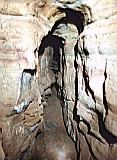 Draebridge Rift
Draebridge Rift Anastomosis
Anastomosis I Buried It In The Sand
I Buried It In The Sand Upper Sandwich gypsum
Upper Sandwich gypsum Exodus/Mayhem Of Pillars
Exodus/Mayhem Of Pillars First half
First half First half
First half Second half
Second half Tight crawl
Tight crawl Tight crawl
Tight crawl Final dig
Final dig Final dig
Final dig Final dig
Final dig Final dig
Final dig Final dig
Final dig Final dig
Final dig Station 13 Passage
Station 13 Passage Gone In The Years South
Gone In The Years South Gone In The Years South
Gone In The Years South Gone In The Years North
Gone In The Years North Gone In The Years North
Gone In The Years North Breakthrough chamber
Breakthrough chamber Multi-junction
Multi-junction Three Amigos!
Three Amigos! Side passage
Side passage Side passage
Side passage Towards Slaughter Canyon
Towards Slaughter Canyon Slaughter Canyon
Slaughter Canyon Slaughter Canyon
Slaughter Canyon Slaughter Canyon
Slaughter Canyon Slaughter Canyon Bypass
Slaughter Canyon Bypass Cryostal
Cryostal Big Country
Big Country Big Country
Big Country Side passage grotto
Side passage grotto Sediment cliff
Sediment cliff Big Country
Big Country Big Country
Big Country Parallel streamway
Parallel streamway Parallel streamway
Parallel streamway Parallel streamway
Parallel streamway Big Country
Big Country Lower Big Country
Lower Big Country Lower Big Country
Lower Big Country Lower Big Country
Lower Big Country Section which sumps
Section which sumps Side passage
Side passage Side passage
Side passage Side passage
Side passage Side passage
Side passage Cryostal
Cryostal Cryostal
Cryostal Big Country choke
Big Country choke Chamber above the choke
Chamber above the choke Decorated alcove
Decorated alcove Decorated alcove
Decorated alcove Decorated alcove
Decorated alcove Decorated alcove
Decorated alcove Decorated alcove
Decorated alcove Decorated alcove
Decorated alcove Decorated alcove
Decorated alcove Decorated alcove before
Decorated alcove before Decorated alcove after
Decorated alcove after Decorated alcove
Decorated alcove Blorenge Inlet
Blorenge Inlet Blorens Inlet
Blorens Inlet Cryostal
Cryostal Mineral Passage barites
Mineral Passage barites Mineral Passage copper oxide
Mineral Passage copper oxide Mineral Passage iron oxide
Mineral Passage iron oxide Blorens Inlet grotto
Blorens Inlet grotto Blorens Inlet grotto
Blorens Inlet grotto Stalagmites
Stalagmites Helictites and straws
Helictites and straws Blorens Inlet grotto
Blorens Inlet grotto Helictites and straws
Helictites and straws Helictites and straws
Helictites and straws With back lighting
With back lighting Helictite aven
Helictite aven Decorated alcove
Decorated alcove Decorated alcove
Decorated alcove Poetic Justice oxbow
Poetic Justice oxbow Poetic Justice oxbow
Poetic Justice oxbow Poetic Justice oxbow
Poetic Justice oxbow Poetic Justice oxbow
Poetic Justice oxbow Poetic Justice oxbow
Poetic Justice oxbow Poetic Justice oxbow
Poetic Justice oxbow Poetic Justice oxbow
Poetic Justice oxbow Poetic Justice oxbowPoetic Justice oxbow
Poetic Justice oxbowPoetic Justice oxbow Poetic Justice oxbow
Poetic Justice oxbow Poetic Justice oxbow
Poetic Justice oxbow Poetic Justice oxbow
Poetic Justice oxbow Poetic Justice
Poetic Justice Poetic Justice
Poetic Justice Poetic Justice Extensions chamber
Poetic Justice Extensions chamber Poetic Justice Extensions chamber
Poetic Justice Extensions chamber Poetic Justice Extensions
Poetic Justice Extensions Poetic Justice III Cryostal
Poetic Justice III Cryostal Cryostal
Cryostal Cryostal
Cryostal Heart with a hole
Heart with a hole Poetic Justice III dig route
Poetic Justice III dig route Crawl to dig
Crawl to dig Poetic Justice III
Poetic Justice III Poetic Justice III nostril
Poetic Justice III nostril Poetic Justice
Poetic Justice Mud drapes
Mud drapes Mud dribbles
Mud dribbles Mud dribbles
Mud dribbles Drip pockets
Drip pockets Heart shaped
Heart shaped Poetic Justice fault chamber
Poetic Justice fault chamber Tombstone climb
Tombstone climb Tombstone chamber
Tombstone chamber Tombstone side passage
Tombstone side passage Ochre stained rock
Ochre stained rock Blorenge Inlet II start
Blorenge Inlet II start Blorenge Inlet II
Blorenge Inlet II Side passage
Side passage Drip pocket
Drip pocket Side passage mud formations
Side passage mud formations Blorenge Inlet II choke
Blorenge Inlet II choke Mn Mud Inlet
Mn Mud Inlet Manganese mud
Manganese mud Mn Mud Inlet end
Mn Mud Inlet end Cryostal in The Black Run
Cryostal in The Black Run Cryostal detail
Cryostal detail The Black Run
The Black Run Cryostal and gypsum
Cryostal and gypsum Cryostal and gypsum
Cryostal and gypsum Cryostal twiglets in Lost in Space
Cryostal twiglets in Lost in Space Cryostal raft
Cryostal raft Cryostal rafts
Cryostal rafts Cryostal raft
Cryostal raft Lost in Space
Lost in Space Cryostal with rafts
Cryostal with rafts Killer Tomato Crawl
Killer Tomato Crawl Gypsum
Gypsum Cryostal rafts
Cryostal rafts Cryostal twiglets
Cryostal twiglets Gypsum
Gypsum Gypsum
Gypsum Gypsum
Gypsum Cryostal and gypsum
Cryostal and gypsum Selenite needles at the squeeze
Selenite needles at the squeeze Gypsum
Gypsum Crystal flakes
Crystal flakes The Killer Tomato
The Killer Tomato The Killer Tomato
The Killer Tomato Lost In Space grotto
Lost In Space grotto Cryogypsum in Intergalactic Overdraught
Cryogypsum in Intergalactic Overdraught Dribbling stal
Dribbling stal Stal overhang
Stal overhang Cryostal
Cryostal Cryostal
Cryostal Cryostal
Cryostal Copper stal closeup
Copper stal closeup Destiny Inlet
Destiny Inlet Destiny Inlet
Destiny Inlet Destiny Inlet
Destiny Inlet Old stal at camp
Old stal at camp Old stal at camp
Old stal at camp Destiny Inlet
Destiny Inlet High Camp Treasures
High Camp Treasures More treasures
More treasures Beaded helictite
Beaded helictite Destiny Inlet
Destiny Inlet Fat v. thin
Fat v. thin Spilled chocolate
Spilled chocolate Junction with WOW
Junction with WOW Mineral coated rocks
Mineral coated rocks Side passage helictites
Side passage helictites Side passage helictites
Side passage helictites Side passage helictites
Side passage helictites Side passage helictites
Side passage helictites Golden Handshake Rift
Golden Handshake Rift Golden Handshake stal
Golden Handshake stal WOW South
WOW South Cryostal in WOW South
Cryostal in WOW South WOW South
WOW South Helictites in WOW South
Helictites in WOW South Mud drips in Soups of the World
Mud drips in Soups of the World WOW North
WOW North Exposed drip pocket
Exposed drip pocket WOW North
WOW North WOW North Choke
WOW North Choke WOW North cryostal
WOW North cryostal WOW North cryostal
WOW North cryostal Anthodites and helictites
Anthodites and helictites Anthodites
Anthodites Aragonite urchin
Aragonite urchin Helictites
Helictites Helictites
Helictites Split helictite
Split helictite Almost-normal stalactite
Almost-normal stalactite Stalagmite
Stalagmite Heligmites
Heligmites Heligmites
Heligmites Main helictite group
Main helictite group Main helictite group
Main helictite group Closeup helictite group
Closeup helictite group Helictite and stalactite detail.
Helictite and stalactite detail. Helictite detail
Helictite detail Helictite detail
Helictite detail Anthodite
Anthodite Upstream MSAD
Upstream MSAD Ochre stained rock
Ochre stained rock Flowstone
Flowstone Upstream MSAD
Upstream MSAD Cryostal
Cryostal Cryostal
Cryostal Grotto
Grotto Grotto flowstone
Grotto flowstone Flowstone
Flowstone Textured calcite
Textured calcite Upstream MSAD
Upstream MSAD Cairn climb
Cairn climb Snowy Christmas Tree
Snowy Christmas Tree Snowy Christmas Tree
Snowy Christmas Tree Snowy Christmas Tree
Snowy Christmas Tree MSAD start
MSAD start MSAD boulder pile
MSAD boulder pile Large section
Large section Largest cross section
Largest cross section Hall Of The One
Hall Of The One Hall Of The One
Hall Of The One Hall Of The One
Hall Of The One Hall Of The One
Hall Of The One Screaming Like A Stuck Pig
Screaming Like A Stuck Pig Screaming Like A Stuck Pig
Screaming Like A Stuck Pig Favosites honeycomb fossil
Favosites honeycomb fossil Squeeze
Squeeze Squeeze
Squeeze High water
High water Helictites
Helictites Flute levers
Flute levers Stalactite cluster
Stalactite cluster Helictite wind vanes
Helictite wind vanes Grotto Passage
Grotto Passage Nicola's Grotto
Nicola's Grotto Nicola's Grotto
Nicola's Grotto Nicola's Grotto
Nicola's Grotto Nicola's Grotto
Nicola's Grotto Nicola's Grotto
Nicola's Grotto Nicola's Grotto
Nicola's Grotto Nicola's Grotto
Nicola's Grotto Nicola's Grotto
Nicola's Grotto Helictites
Helictites Helictites
Helictites Bat skeleton
Bat skeleton Fallen helictites
Fallen helictites Bedding helictites
Bedding helictites Decorated alcove
Decorated alcove Old grotto
Old grotto Old grotto
Old grotto Above the grotto
Above the grotto Fallen stal
Fallen stal Helictite cluster
Helictite cluster Helictite cluster
Helictite cluster Old stal
Old stal Old stal
Old stal Fallen helictites
Fallen helictites Old stal
Old stal Passage ceiling
Passage ceiling Fallen wafers
Fallen wafers Final passage
Final passage Final grotto
Final grotto Final grotto
Final grotto Grotto Passage columns
Grotto Passage columns Helictite columns
Helictite columns Grotto Passage columns
Grotto Passage columns Helictite closeup
Helictite closeup Grotto end
Grotto end Distant helictites
Distant helictites Distant helictites
Distant helictites Grotto wall
Grotto wall Grotto wall
Grotto wall Undercut helictites
Undercut helictites Undercut helictites
Undercut helictites Initial climb
Initial climb Initial chambers
Initial chambers In high water
In high water Early Into The Black
Early Into The Black Mud laminates
Mud laminates Sand layers
Sand layers Periglacial Rhythmites
Periglacial Rhythmites Later Into The Black
Later Into The Black Rock And Roll Choke
Rock And Roll Choke Yellow Van Passage
Yellow Van Passage Gypsum filled hole
Gypsum filled hole Traverse
Traverse Traverse
Traverse Top Banana
Top Banana Top Spots
Top Spots Top Spots
Top Spots Crawl from Top Spots
Crawl from Top Spots Removed squeeze
Removed squeeze Approach passage
Approach passage Far side closeup
Far side closeup Side wall
Side wall Column base
Column base Stalagmite
Stalagmite Aragonite bunch
Aragonite bunch Aragonite tree
Aragonite tree From the side
From the side Isle of Man
Isle of Man Side view
Side view Undercut
Undercut Crossing the chamber
Crossing the chamber Far side
Far side Small cluster
Small cluster Medium cluster
Medium cluster Large cluster
Large cluster Bunch of grapes
Bunch of grapes Eyehole climb
Eyehole climb First formations
First formations First formations
First formations First formations frill
First formations frill Forked tongue
Forked tongue Second formations
Second formations Second formations
Second formations Circus Maximus
Circus Maximus Anthodites
Anthodites Aragonite
Aragonite Mutated stalactite
Mutated stalactite Main collection
Main collection Aragonite pom pom
Aragonite pom pom Baobab
Baobab Fracture formation
Fracture formation Triangular
Triangular Bidirectional
Bidirectional Split ranks
Split ranks Small cluster
Small cluster Large cluster
Large cluster The grotto
The grotto Grotto side
Grotto side Oxbow wall
Oxbow wall Flowstone waterfall
Flowstone waterfall The undercut
The undercut Undercut detail
Undercut detail Upper wall detail
Upper wall detail Gypsum crystals
Gypsum crystals Old helictites
Old helictites Old helictites
Old helictites Old helictites
Old helictites Stalagmites
Stalagmites Active helictites
Active helictites Helictites
Helictites Gypsum formations
Gypsum formations The Pineapple Patch
The Pineapple Patch Gypsum coating
Gypsum coating Cryostal rafts
Cryostal rafts Cryostal rafts
Cryostal rafts Cryogenic gypsum
Cryogenic gypsum Cryogenic gypsum
Cryogenic gypsum Selenite needles
Selenite needles Selenite needle
Selenite needle Cryostal lattice
Cryostal lattice Cryostal lattices
Cryostal lattices Cryostal lattice
Cryostal lattice Normal stalactites
Normal stalactites Textured stalagmite
Textured stalagmite Textured stalagmite
Textured stalagmite Stal-covered gypsum
Stal-covered gypsum Calcite bobbles
Calcite bobbles Stal-covered gypsum
Stal-covered gypsum Medusa's Children
Medusa's Children Medusa's Children
Medusa's Children Whitewashed gypsum
Whitewashed gypsum Medusa's Children
Medusa's Children Medusa's Children
Medusa's Children Helictites and whitewash
Helictites and whitewash Stalagmites
Stalagmites Medusa's Children
Medusa's Children Medusa's Children chamber
Medusa's Children chamber Overwhelmed by helictites.
Overwhelmed by helictites. Medusa's Children.
Medusa's Children. Medusa's Children stalagmites
Medusa's Children stalagmites Column tops
Column tops Long helictites
Long helictites Long helictites
Long helictites Medusa's Children
Medusa's Children Medusa's Children
Medusa's Children With human for scale
With human for scale Fallen helictites
Fallen helictites Far side
Far side Far side
Far side Beyond Medusa's Children
Beyond Medusa's Children Cauliflower
Cauliflower Helictites and aven
Helictites and aven In the aven
In the aven Continuing helictites
Continuing helictites Continuing helictites
Continuing helictites Continuing helictites
Continuing helictites Whitewashed gypsum
Whitewashed gypsum Whitewash patches
Whitewash patches Stooping section
Stooping section Pointing helictite
Pointing helictite Near Lightbulb Chamber
Near Lightbulb Chamber Anthodites
Anthodites Near Lightbulb Chamber.
Near Lightbulb Chamber. Lightbulb Chamber
Lightbulb Chamber Lightbulb Chamber
Lightbulb Chamber The Lightbulb
The Lightbulb Cryostal
Cryostal Rock bands
Rock bands Walking section
Walking section Scallops
Scallops Main passage
Main passage The Geryon's Lair
The Geryon's Lair The Geryon
The Geryon The three heads of The Geryon
The three heads of The Geryon The Geryon
The Geryon The Geryon
The Geryon Father and baby
Father and baby Mother and unbilical cord
Mother and unbilical cord Geryon's Lair
Geryon's Lair Catherine wheel
Catherine wheel Large anthodites
Large anthodites Geryon's Lair
Geryon's Lair Geryon's Lair anthodites
Geryon's Lair anthodites The Geryon's Lair
The Geryon's Lair Anthodite closeup
Anthodite closeup The Needles
The Needles The Needles
The Needles The Needles
The Needles The Needles
The Needles Low-level chamber
Low-level chamber